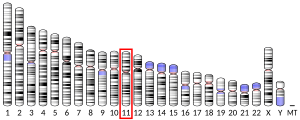Neurotrimin
Aparença
El neurotrimin és una proteïna que en humans està codificada pel gen NTM.[5][6]
Aquest gen codifica un membre de la família IgLON (LAMP, OBCAM, Ntm) de immunoglobulina (Ig) que dominen-contenen glicosilfosfatidilinositol (GPI) ancorades a les molècula d'adhesió cel·lular. La proteïna codificada pot promoure el creixement i l'adhesió de neurites a través d'un mecanisme homòfil. Aquest gen està estretament lligat a un membre d'una família relacionada, un opioide d'unió proteïna / molècula d'adhesió cel·lular (OPCML), en el cromosoma 11. S'han trobat diverses variants alternades alternativament, però només dues variants han tingut les seqüències de longitud completa determinades.[6]
Referències
[modifica]- ↑ 1,0 1,1 1,2 GRCh38: Ensembl release 89: ENSG00000182667 - Ensembl, May 2017
- ↑ 2,0 2,1 2,2 GRCm38: Ensembl release 89: ENSMUSG00000059974 – Ensembl, May 2017
- ↑ «Human PubMed Reference:». National Center for Biotechnology Information, U.S. National Library of Medicine.
- ↑ «Mouse PubMed Reference:». National Center for Biotechnology Information, U.S. National Library of Medicine.
- ↑ «Cloning of neurotrimin defines a new subfamily of differentially expressed neural cell adhesion molecules». J Neurosci, 15, 3 Pt 2, Apr 1995, pàg. 2141–56. PMID: 7891157.
- ↑ 6,0 6,1 «Entrez Gene: HNT neurotrimin».
Bibliografia
[modifica]- Bonaldo MF, Lennon G, Soares MB «Normalization and subtraction: two approaches to facilitate gene discovery.». Genome Res., 6, 9, 1997, pàg. 791–806. DOI: 10.1101/gr.6.9.791. PMID: 8889548.
- Wistow G, Bernstein SL, Wyatt MK, et al «Expressed sequence tag analysis of human RPE/choroid for the NEIBank Project: over 6000 non-redundant transcripts, novel genes and splice variants.». Mol. Vis., 8, 2002, pàg. 205–20. PMID: 12107410.
- Strausberg RL, Feingold EA, Grouse LH, et al «Generation and initial analysis of more than 15,000 full-length human and mouse cDNA sequences.». Proc. Natl. Acad. Sci. U.S.A., 99, 26, 2003, pàg. 16899–903. DOI: 10.1073/pnas.242603899. PMC: 139241. PMID: 12477932.
- Sellar GC, Watt KP, Rabiasz GJ, et al «OPCML at 11q25 is epigenetically inactivated and has tumor-suppressor function in epithelial ovarian cancer.». Nat. Genet., 34, 3, 2003, pàg. 337–43. DOI: 10.1038/ng1183. PMID: 12819783.
- Clark HF, Gurney AL, Abaya E, et al «The secreted protein discovery initiative (SPDI), a large-scale effort to identify novel human secreted and transmembrane proteins: a bioinformatics assessment.». Genome Res., 13, 10, 2003, pàg. 2265–70. DOI: 10.1101/gr.1293003. PMC: 403697. PMID: 12975309.
- Zhang Z, Henzel WJ «Signal peptide prediction based on analysis of experimentally verified cleavage sites.». Protein Sci., 13, 10, 2005, pàg. 2819–24. DOI: 10.1110/ps.04682504. PMC: 2286551. PMID: 15340161.
- Liu J, Li G, Peng X, et al «The cloning and preliminarily functional analysis of the human neurotrimin gene.». Sci. China, C, Life Sci., 47, 2, 2004, pàg. 158–64. DOI: 10.1360/03yc0072. PMID: 15379248.
- Gerhard DS, Wagner L, Feingold EA, et al «The status, quality, and expansion of the NIH full-length cDNA project: the Mammalian Gene Collection (MGC).». Genome Res., 14, 10B, 2004, pàg. 2121–7. DOI: 10.1101/gr.2596504. PMC: 528928. PMID: 15489334.





